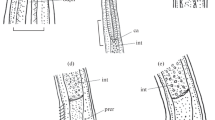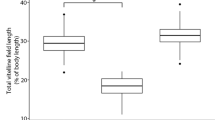Abstract
Two new species of the rare nematode family Creagrocercidae from earthworms are described and illustrated. Creagrocercus braziliensis n. sp. is distinguished from the type-species, C. barbatus Baylis, 1943, by: the presence of four cephalic papillae (vs a pair of finger-shaped latero-ventral processes) on the head; larger amphids; a more posterior excretory pore position; a shorter pharynx which is remarkably expanded at the base; the nerve-ring situated just posterior to the base of the pharynx (vs at mid-pharyngeal level); an anal aperture present in the females; anterior ovary and testis reach just into the anterior half of the body (vs closely posterior to the pharynx); equal, similar (vs unequal, dissimilar) spicules; and a prominent, unpaired precloacal papilla in males. Creagrocercus drawidae n. sp. is related to C. barbatus by a similar pharyngeal shape and the presence of a tail ‘hook’, and to C. braziliensis n. sp. by: the lack of finger-shaped processes on the head and the presence of four cephalic papillae; a similar position of the excretory pore; a similar arrangement and length of the reproductive system; the presence of unpaired precloacal papilla in males; similar, almost equal spicules; and the presence of a tail ‘hook’. From both of these species C. drawidae differs by having: a much shorter body and pharynx; larger amphids; a more posterior nerve-ring position; larger and less numerous eggs; greatly inflated (vs flat) vulval lips; shorter spicules; and a smaller caudal ‘hook’. For C. drawidae, the partial sequences of the SSU (18S) rDNA and the D2D3 segment of LSU (28S) rDNA were obtained and subjected to phylogenetic analyses. The phylogenetic affiliations of the Creagrocercidae are discussed.




Similar content being viewed by others
References
Altschul, S. F., Gish, W., Miller, W., Myers, E. W., & Lipman, D. J. (1990). Basic local alignment search tool. Journal of Molecular Biology, 215, 403–410.
Baylis, H. A. (1943). Some nematode parasites of earthworms from the Indo-Malay region. Parasitology, 35, 112–127.
Coleman, C. O. (2003). “Digital inking”: how to make perfect line drawings on computers. Organisms, Diversity and Evolution, 3, Electronic Supplement, 14, 1–14.
Edwards, C. A., & Bohlen, P. J. (Eds) (2005). Biology and ecology of earthworms. Third edition. London: Chapman & Hall, 433 pp.
Erséus, C. (2005). Phylogeny of oligochaetous Clitellata. Hydrobiologia, 535/536, 357–372.
Floyd, R., Abebe, E., Papert, A., & Blaxter, M. (2002). Molecular barcodes for soil nematode identification. Molecular Ecology, 11, 839–850.
Holovachov, O. (2006). Morphology and systematics of the order Plectida Malakhov, 1982 (Nematoda). PhD Thesis, Wageningen University and Research Centre, 244 pp.
James, S. (2009). Phylogeny of Crassiclitellata. Abstracts of the Fourth International Oligochaete Taxonomy Meeting, April 20–24, 2009, Turkey.
Jamieson, B. G. M. (1988). On the phylogeny and higher classification of the Oligochaeta. Cladistics, 4, 367–401.
Jamieson, B. G. M., Tillier, S., Tillier, A., Justine, J.-L., Ling, E., James, S., et al. (2002). Phylogeny of the Crassiclitellata (Annelida, Oligochaeta): combined versus partitioned analysis using nuclear (28S) and mitochondrial (12S, 16S) r DNA. Zoosystema, 24, 707–734.
Nuin, P. A. S. (2005). MTgui – a simple interface to ModelTest. Program distributed by the author. University of Toronto. http://www.genedrift.org/mtgui.php.
Poinar, G. O., Jr. (1978). Associations between nematodes (Nematoda) and oligochaetes (Annelida). Proceedings of the Helminthological Society of Washington, 45, 202–210.
Posada, D., & Crandall, K. A. (1998). Modeltest: testing the model of DNA substitution. Bioinformatics, 14, 817–818.
Seinhorst, J. W. (1959). A rapid method for the transfer of nematodes from fixative to anhydrous glycerin. Nematologica, 4, 54–60.
Spiridonov, S. E. (2001). Parasitic organisms from tropical earthworms deposited in the Royal Museum of Central Africa. Annales. Musée Royal de l’Afrique Centrale. Tervuren. Sciences Zoologiques, 285, 19–27.
Spiridonov, S. E., & Ivanova, E. S. (2005). [The nematodes of the superfamily Drilonematoidea, parasites of earthworms]. Moscow: Tovarischestvo Nauchnyh Izdaniy KMK, 296 pp.
Swofford, D. L. (1998). PAUP*. Phylogenetic analysis using parsimony. Version 4. Sinauer, Sunderland, MA.
Timm, R. W. (1959). Observations on Synoecnema (Nematoda, Ungellidae), with a description of two new species. Pakistan Journal of Scientific Research, 11, 58–62.
Timm, R. W. (1962a). Nematode parasites of the coelomic cavity of earthworms. I. The genera Synoecnema and Ungella. Biologia (Dacca), 8, 1–7.
Timm, R. W. (1962b). Nematode parasites of the coelomic cavity of earthworms. II. The genus Dicelis. Biologia (Dacca), 8, 9–16.
Timm, R. W. (1966a). Nematode parasites of the coelomic cavity of earthworms. III. Homungella new genus (Drilonematoidea: Homungellidae new family). Biologia (Dacca), 12, 1–5.
Timm, R. W. (1966b). Nematode parasites of the coelomic cavity of earthworms. IV. Siconema new genus (Drilonematoidea: Ungellidae) with a description of 10 new species. Biologia (Dacca), 12, 7–21.
Timm, R. W. (1966c). Nematode parasites of the coelomic cavity of earthworms. VI. Macramphida and Sucamphida, two new genera with unusual amphids. Proceedings of the Helminthological Society of Washington, 33, 67–71.
Timm, R. W. (1967a). Nematode parasites of the coelomic cavity of earthworms VII. Four new genera and thirteen new species of the family Drilonematidae. Pakistan Journal of Biological and Agricultural Sciences, 10, 1–17.
Timm, R. W. (1967b). Nematode parasites of the coelomic cavity of earthworms. VIII. Four new genera and seven new species of the family Ungellidae. Pakistan Journal of Scientific Research, 10, 13–21.
Timm, R. W. (1967c). Nematode parasites of the coelomic cavity of earthworms. IX. The family Scolecophilidae. Pakistan Journal of Biological and Agricultural Sciences, 10, 22–24.
Timm, R. W. (1971). Nematode parasites of the coelomic cavity of earthworms. X. A new genus and two new species from New Guinea. Proceedings of the Helminthological Society of Washington, 38, 252–256.
van Megen, H., van den Elsen, S., Holterman, M., Karssen, G., Mooyman, P., Bongers, T., et al. (2009). A phylogenetic tree of nematodes based on about 1200 full-length small subunit ribosomal DNA sequences. Nematology, 11, 927–950.
Acknowledgements
This research was supported by grants 08-04-00209 and 09-04-90300 from the Russian Foundation for Basic Research. The first author gratefully acknowledges the financial support provided by the Natural History Museum of Geneva, Switzerland, and is grateful for the loan of specimens.
Author information
Authors and Affiliations
Corresponding author
Rights and permissions
About this article
Cite this article
Ivanova, E.S., Spiridonov, S.E. Two new species of creagrocercid nematodes parasitic in earthworms, with comments on the phylogenetic affiliations of the Creagrocercidae Baylis, 1943. Syst Parasitol 78, 81–94 (2011). https://doi.org/10.1007/s11230-010-9276-5
Received:
Accepted:
Published:
Issue Date:
DOI: https://doi.org/10.1007/s11230-010-9276-5




